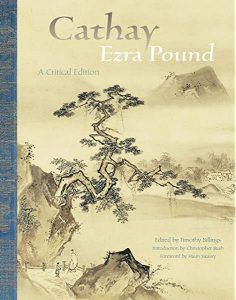J L Wall in Kirk Center:
 What are we to do with Ezra Pound? One answer would be to “cancel” him, to dump his statue in some river and let the water erase it. This wouldn’t be without cause: calling his politics and personality repugnant is an understatement. But it would also be too simple. Pound’s fingerprints are everywhere: most famously on The Waste Land, but also on the careers of Yeats, Frost, William Carlos Williams, and H. D. (Hilda Doolittle); on the publication of Joyce’s Ulysses; on Imagism, Vorticism, and the “New Poetry” that emerged in Poetry a century ago. He was, inescapably, one of the pivotal figures of twentieth-century literature. If we have to live with Pound, the necessary question is how: merely as a player in literary history or also as the author of literature still worth reading?
What are we to do with Ezra Pound? One answer would be to “cancel” him, to dump his statue in some river and let the water erase it. This wouldn’t be without cause: calling his politics and personality repugnant is an understatement. But it would also be too simple. Pound’s fingerprints are everywhere: most famously on The Waste Land, but also on the careers of Yeats, Frost, William Carlos Williams, and H. D. (Hilda Doolittle); on the publication of Joyce’s Ulysses; on Imagism, Vorticism, and the “New Poetry” that emerged in Poetry a century ago. He was, inescapably, one of the pivotal figures of twentieth-century literature. If we have to live with Pound, the necessary question is how: merely as a player in literary history or also as the author of literature still worth reading?
…So let’s speak plainly. Pound was a central figure of twentieth-century literary history, without whom lasting, enduring works would not have taken the shapes they did. He was a talented, innovative poet—up until his mid-thirties. But the Cantos, on which he staked his reputation, were a failure. The modernist scholar Lawrence Rainey referred to them as “The Monument of Culture.” The truth is that they were born ruins. To find beauty in them, we have to do something like what Pound did in Cathay: read the word-by-word glosses and ignore the paraphrases. The reason is this: when we do try to make sense of them, they descend too often into secrecy, paranoia, and conspiracy. It’s not that there’s no “there” there—it’s that what is there far too often isn’t worthwhile.
Pound will endure, though, because in any honest literary history he must. The poems will, too—at least some of them, the early translations like Cathay especially. Billings’s scholarship makes the case for that—and for “The Seafarer,” “Homage to Sextus Propertius,” and the first Canto. Despite the ugliness of his person, some of what Pound created remains lastingly beautiful.
More here.
